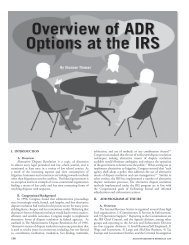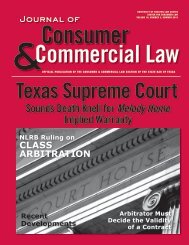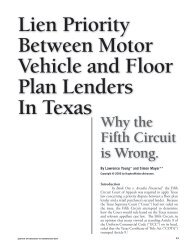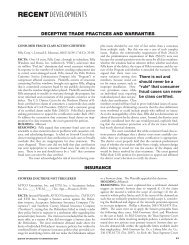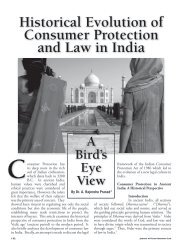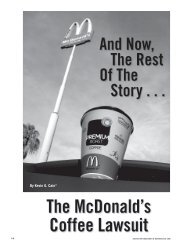Teaching Consumer Credit Law in an Evolving Australian Economy
Teaching Consumer Credit Law in an Evolving Australian Economy
Teaching Consumer Credit Law in an Evolving Australian Economy
Create successful ePaper yourself
Turn your PDF publications into a flip-book with our unique Google optimized e-Paper software.
(two groups would undertake the same<br />
tasks) on which problem scenarios were<br />
based. Obviously, names were ch<strong>an</strong>ged <strong>an</strong>d<br />
facts altered to ensure client privacy <strong>an</strong>d to<br />
make the tasks m<strong>an</strong>ageable for the students.<br />
The Preparation of a M<strong>an</strong>ual for Use by<br />
the Students Dur<strong>in</strong>g the Exercise.<br />
The m<strong>an</strong>ual <strong>in</strong>cludes a summary of<br />
the subst<strong>an</strong>tive law, material relev<strong>an</strong>t to<br />
file m<strong>an</strong>agement, client <strong>in</strong>terview<strong>in</strong>g, <strong>an</strong>d<br />
legal writ<strong>in</strong>g. Clearly, a priority for us was<br />
to ensure the students received a basic <strong>in</strong>troduction to the new<br />
laws before undertak<strong>in</strong>g the practicum. We were m<strong>in</strong>dful that we<br />
needed to provide <strong>an</strong> appropriate <strong>in</strong>troduction to the area without<br />
underm<strong>in</strong><strong>in</strong>g the self-directed learn<strong>in</strong>g we w<strong>an</strong>ted to achieve.<br />
To this end, we prepared summaries <strong>an</strong>d resources to assist<br />
students <strong>in</strong> embark<strong>in</strong>g on their tasks. We <strong>in</strong>cluded <strong>an</strong> overview of<br />
Australi<strong>an</strong> <strong>Consumer</strong> <strong>Credit</strong> <strong>Law</strong>, historical material, extracts of<br />
the legislation, <strong>an</strong>d <strong>an</strong> overview of the new legislative scheme. The<br />
follow<strong>in</strong>g materials specific to particular problems were provided:<br />
• Responsible lend<strong>in</strong>g<br />
• Hardship variation<br />
• Asset lend<strong>in</strong>g<br />
• Debt collection<br />
• Payday lend<strong>in</strong>g<br />
• B<strong>an</strong>k<strong>in</strong>g Code of Practice<br />
• F<strong>in</strong><strong>an</strong>cial Ombudsm<strong>an</strong> Service<br />
• <strong>Credit</strong> Ombudsm<strong>an</strong> Service<br />
• Telecommunications Ombudsm<strong>an</strong> Service<br />
• F<strong>in</strong><strong>an</strong>cial Counsellors<br />
One (2-hour) Introductory Lecture<br />
To ensure students understood the nature of the practicum<br />
<strong>an</strong>d the basic material, we held one <strong>in</strong>troductory lecture. This<br />
was the only formal lecture on consumer credit for the semester.<br />
Dur<strong>in</strong>g the first hour of the lecture, the academic staff spoke<br />
about the project, its aims, <strong>an</strong>d the assessment process, <strong>an</strong>d<br />
provided a brief framework of Australi<strong>an</strong> consumer credit laws<br />
<strong>an</strong>d associated legislation. The second hour was a presentation<br />
from a representative of the CCLSWA regard<strong>in</strong>g its role <strong>in</strong><br />
deal<strong>in</strong>g with clients <strong>an</strong>d case m<strong>an</strong>agement. The purpose of this<br />
presentation is to provide students with practical <strong>in</strong>sights <strong>an</strong>d<br />
<strong>in</strong>formation from a practitioner <strong>in</strong> the field. We <strong>an</strong>ticipate the<br />
presentation will assist this process through <strong>an</strong> <strong>in</strong>troduction to<br />
the nature of CCLSWA’s responsibilities <strong>an</strong>d client base, as well<br />
as the import<strong>an</strong>ce <strong>an</strong>d practice of “day-to-day” tasks such as file<br />
m<strong>an</strong>agement <strong>an</strong>d client <strong>in</strong>terview<strong>in</strong>g.<br />
Preparation <strong>an</strong>d Submission of the File <strong>an</strong>d Letter of Advice<br />
Students were required to keep a paper file <strong>an</strong>d <strong>an</strong> e-file.<br />
The paper file conta<strong>in</strong>s relev<strong>an</strong>t correspondence, documents, <strong>an</strong>d<br />
research, <strong>an</strong>d is reviewed by the academic staff throughout the<br />
project. A small portion of the marks allocated for the project<br />
will be for file m<strong>an</strong>agement. Students are required to submit the<br />
assessable items from the exercise (<strong>in</strong> their e-file) onl<strong>in</strong>e.<br />
Provision of Feedback<br />
The first memor<strong>an</strong>dum of advice was prepared <strong>an</strong>d submitted<br />
<strong>in</strong> April. It will be used as a model to assist students <strong>in</strong> prepar<strong>in</strong>g<br />
their own memor<strong>an</strong>dums.<br />
Presentation of F<strong>in</strong>d<strong>in</strong>gs by Student Groups<br />
Upon completion of the project, each group will present a<br />
brief overview of their problem <strong>an</strong>d their f<strong>in</strong>d<strong>in</strong>gs. Also, to ensure<br />
Although at the time of<br />
writ<strong>in</strong>g the practicum<br />
was yet to be completed,<br />
we are already look<strong>in</strong>g<br />
forward to improv<strong>in</strong>g,<br />
supplement<strong>in</strong>g, <strong>an</strong>d<br />
streaml<strong>in</strong><strong>in</strong>g the project<br />
for 2013.<br />
that students receive a b<strong>an</strong>k of material<br />
on consumer credit, the submissions for<br />
all the problems will be posted onl<strong>in</strong>e.<br />
Therefore, students will have access<br />
to a considerable amount of material<br />
<strong>in</strong>volv<strong>in</strong>g a variety of consumer credit<br />
scenarios.<br />
Assessment of the Project’s Effectiveness<br />
After completion of the practicum, we<br />
will reflect on the project by:<br />
(i) Seek<strong>in</strong>g written feedback from all<br />
students;<br />
(ii) Org<strong>an</strong>is<strong>in</strong>g a small discussion group of students<br />
(perhaps one from each group <strong>an</strong>d others, if<br />
<strong>in</strong>terested);<br />
(iii) Discussion <strong>an</strong>d review from the <strong>Teach<strong>in</strong>g</strong> <strong>an</strong>d<br />
Learn<strong>in</strong>g Committee (<strong>Law</strong>)<br />
Dissem<strong>in</strong>ation of Information About the Project<br />
We hope to share our experience <strong>in</strong> develop<strong>in</strong>g the<br />
practicum with others <strong>an</strong>d seek advice so we c<strong>an</strong> improve it <strong>in</strong><br />
years to come. This conference is a wonderful start <strong>an</strong>d we are<br />
grateful for the opportunity to be <strong>in</strong>volved. We are writ<strong>in</strong>g a<br />
journal article about the practicum <strong>an</strong>d are speak<strong>in</strong>g about it at<br />
local <strong>an</strong>d national teach<strong>in</strong>g forums.<br />
Project Susta<strong>in</strong>ability<br />
Once established, the project will be able to cont<strong>in</strong>ue <strong>in</strong><br />
subsequent years without cont<strong>in</strong>ued fund<strong>in</strong>g. The m<strong>an</strong>ual will<br />
simply require <strong>an</strong>nual updat<strong>in</strong>g by members of the faculty. New<br />
case examples will be provided <strong>an</strong>nually by CCLSWA. After<br />
work<strong>in</strong>g with CCLSWA representatives to <strong>in</strong>itiate the project<br />
<strong>in</strong> 2012, the academic staff will be well equipped to prepare new<br />
scenarios from case studies <strong>in</strong> subsequent years. The specialist<br />
lecture will be recorded for repeated use, although CCLSWA has<br />
offered to attend each year. The m<strong>an</strong>ual will be available onl<strong>in</strong>e,<br />
so there will be no upfront or recurr<strong>in</strong>g pr<strong>in</strong>t<strong>in</strong>g costs; <strong>an</strong>d the<br />
<strong>Consumer</strong> <strong>Law</strong> teach<strong>in</strong>g team are members of the M<strong>an</strong>agement<br />
Committee of CCLSWA <strong>an</strong>d are <strong>in</strong> regular contact with the<br />
org<strong>an</strong>ization.<br />
Hopes for the Future<br />
Although at the time of writ<strong>in</strong>g the practicum was yet to be<br />
completed, we are already look<strong>in</strong>g forward to improv<strong>in</strong>g,<br />
supplement<strong>in</strong>g, <strong>an</strong>d streaml<strong>in</strong><strong>in</strong>g the project for 2013. We have<br />
already discovered several matters we will approach differently<br />
<strong>in</strong> com<strong>in</strong>g years <strong>an</strong>d we are sure we will learn more after the<br />
feedback sessions with the students. So far we have recognized:<br />
• The import<strong>an</strong>ce of very specific <strong>in</strong>structions. This<br />
sounds obvious, but even with the most careful craft<strong>in</strong>g<br />
of <strong>in</strong>structions, students are likely to come up with<br />
multiple <strong>in</strong>terpretations;<br />
• The benefits of work<strong>in</strong>g <strong>in</strong> groups. Despite some<br />
grumbl<strong>in</strong>g about the group allocations, which were<br />
for the most part r<strong>an</strong>dom, we believe this is a useful<br />
exercise, as practitioners must learn to work with a<br />
variety of people <strong>an</strong>d personalities.<br />
• The need to make scenarios as lifelike as possible.<br />
For example, we hope to improve the client<strong>in</strong>terview<strong>in</strong>g<br />
component to make it more realistic,<br />
<strong>an</strong>d <strong>in</strong>clude <strong>an</strong> assessable component for client<br />
<strong>in</strong>terview<strong>in</strong>g.<br />
• The import<strong>an</strong>ce of mak<strong>in</strong>g students feel “part” of<br />
the project <strong>an</strong>d place emphasis on their feedback<br />
6 Journal of <strong>Consumer</strong> & Commercial <strong>Law</strong>



